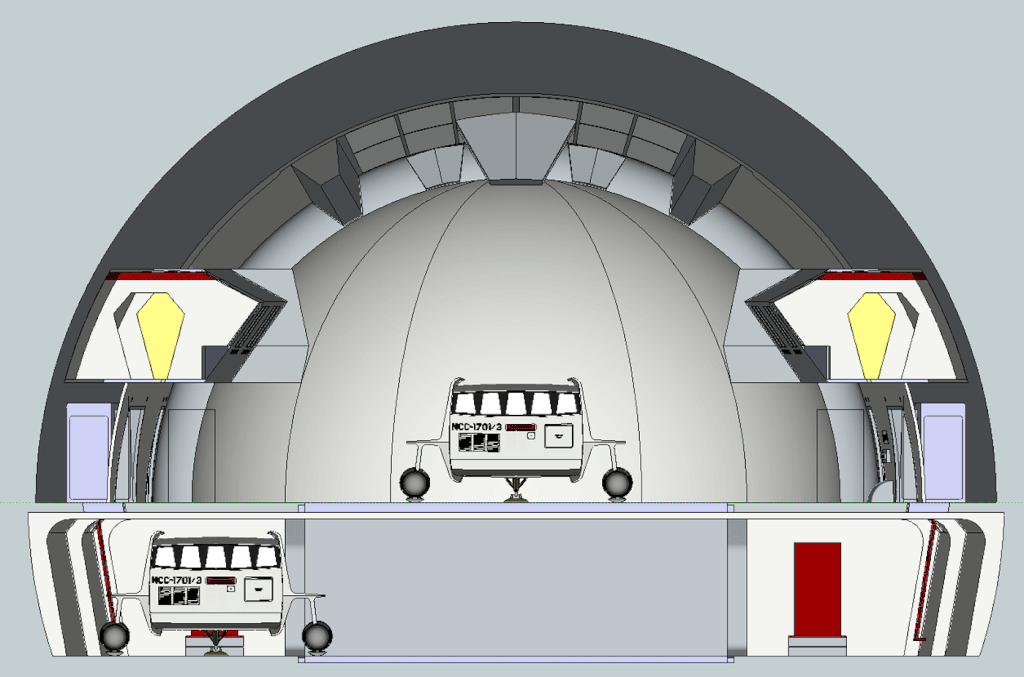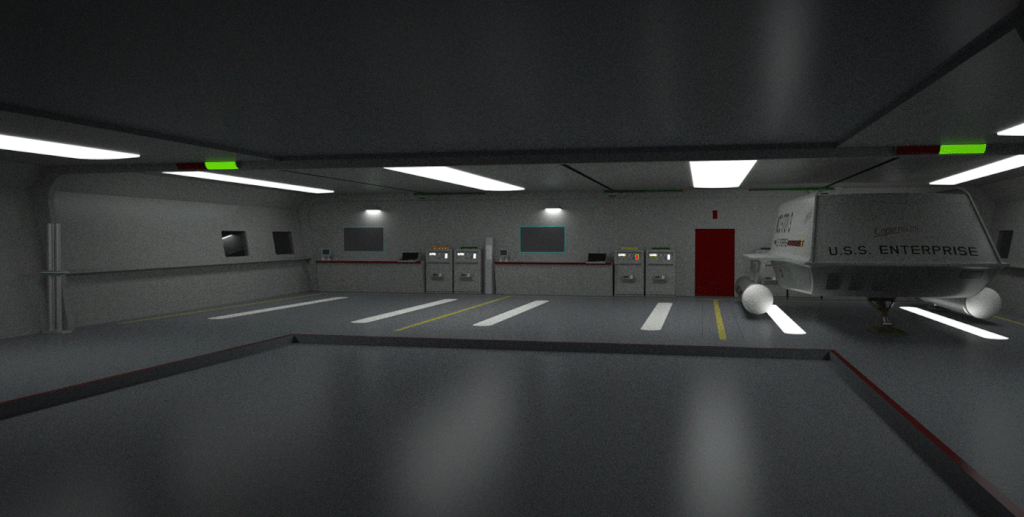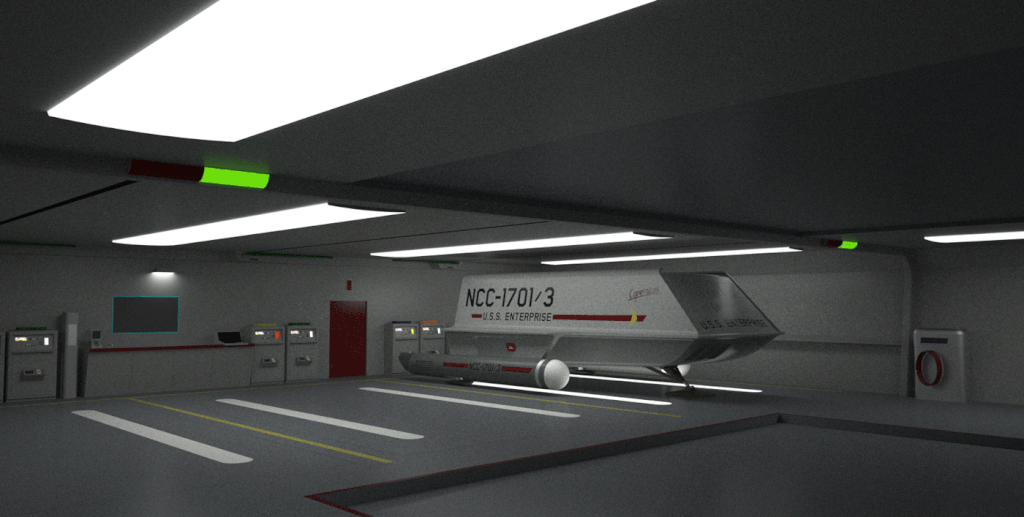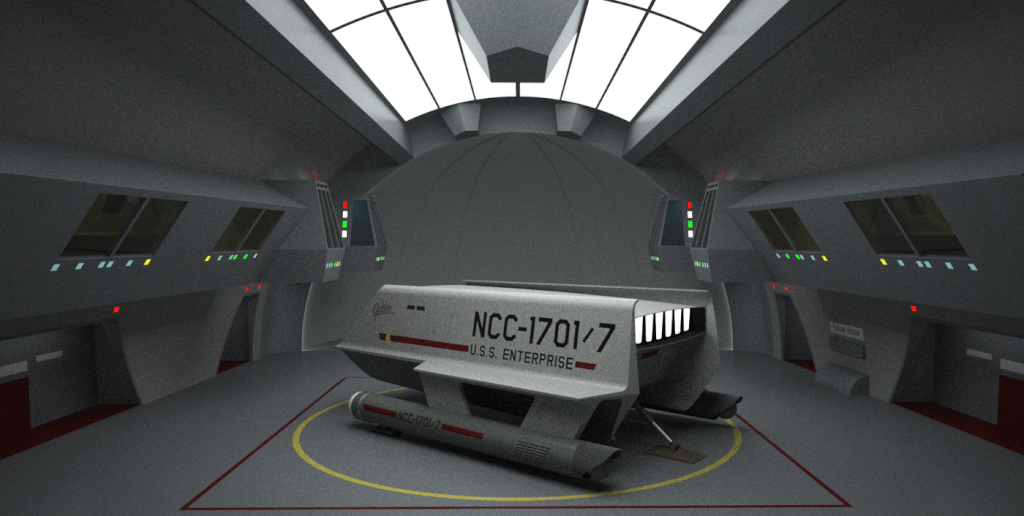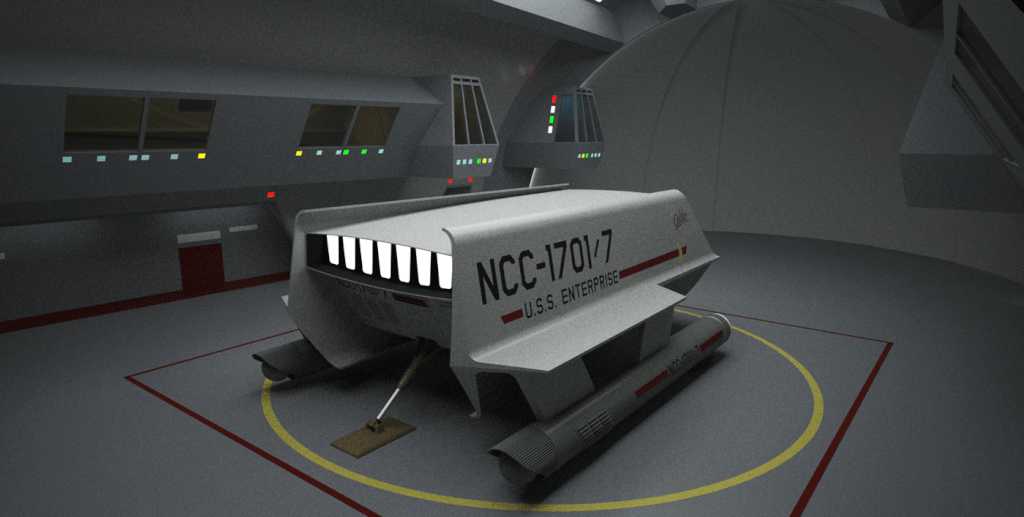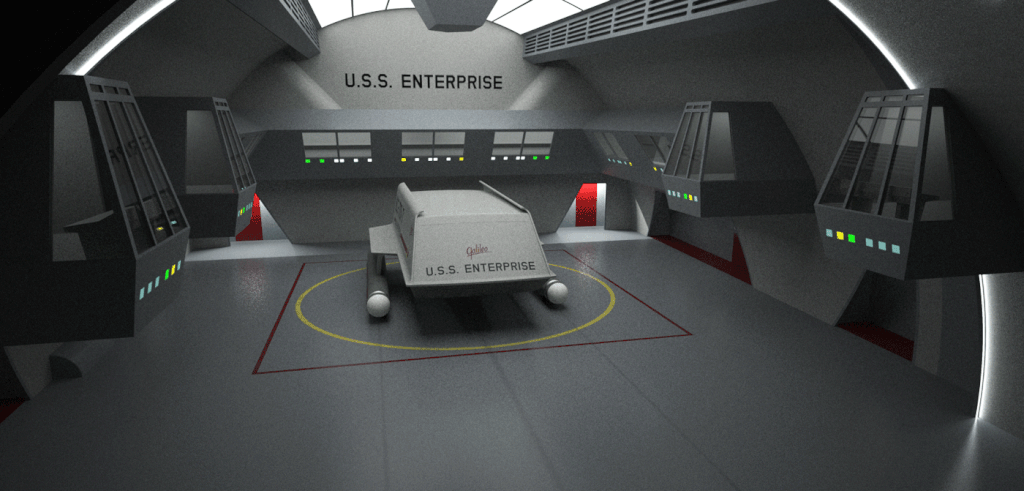Last April I made an effort to put some things to rest by actually modeling in 3D. This exercise along with discussion, insight and input on this board and another helped clarify some things.
As realistic as we ;ike to imagine
Star Trek to be ultimately we must remember they were making a television show--they were depecting a fictional reality.. And within that context compromises were made for the sake of production realities like available space, resources, time and money.
It's widely accpeted (or should be) that the shuttlecraft replicas, both inside and out, were all productions compromises in some for or other. And this extend to the hangar deck miniature as well.
Setting aside the original concept MJ had the design we actually was pretty sweet, but due to aforementioned compromise it's a challenge to get a handle on how big the "real" shuttlecraft was supposed to be. From the original drawings as well as recorded comments by those who oversaw building the replica the initial approach was that the shuttlecraft was
supposed to have a somewhat cramped interior.
When you look at the drawings for the vehicel in The Making Of Star Trek you can clearly see this wasn't envisioned as a really large craft with room to spare inside. MJ understood right off te was a limit to how big the craft could realistically be and still fit comfortably within the available space of a 947 ft. starship. The onscreen evidence to that original intent can be best seen with the chairs inside the shuttlecraft interior--they were set unusually low to the floor. The reason for that was because the interior set was meant to have a lower ceiling and the still wanted to be able to film over the actors' shoulders. The interior set, including the chairs, were already well along in construction when word came down that they wanted to roof raised to help accomodate the bulky cameras of the day and facilitate filming. It also would make it easier for the actors to move around (today this wouldn't be an issue with the compact handicams available). They weren't going to redo a lot of work unless they absolutely had to so only the walls and ceiling were modified. The interior was also built in separate 4 ft. sections that could be moved apart to allow more flexibility in filming. Finally an aft compartment was added because one was called for in the script.
So due to production realities we now have an interior set much larger and taller than was originally planned. This also explains why the forward bulkhead is at a steeper angle than the exterior hull because it had to be reshaped to meet up with the now higher ceiling. It was simply hoped no one would really notice the discrepency on the television screen.
Now to further complicate things. The exterior mockup was built smaller than originally designed simply because it had to be manageable enough to transport and move about the stage. We have an onscreen reference to "a 24 ft. shuttlecraft" yet we have a 22 ft. studio mockup neither of which could accommodate the full size interior set we see.
The final complication is the hangar deck miniature. it was made to reflect a significantly larger interior than was actually possible within a the available space at the aft end of the secondary hull of a 947 ft. starship. It isn't so much the width of the miniature, but the length is grossly exaggerrated to foster a sense of a vast space. This illusion was enhanced by the set not having a back wall from where the filming camaera was placed. Throw in a small miniature replica based on an already small full size mockup and you have quite a distorted impression of what the "real" setup would really look like.
MJ knew the miniature hangar was a distortion because in his cross-section of the
Enterprise seen in TMoST as well as his drawings for the Phase II refit you can clearly see the hangar bay is distinctly smaller than what we see onscreen. The miniature set seen onscreen would extend forward under the engine support pylons similarly to how Franz Jospeh drew it in his tech manual and blueprints. So FJ's drawings are based on the miniature set and not how it would really look like.
The exercise I went through was to come up with a shuttlecraft that looked near exactly like it does onscreen, both exterior and interior, while acknowledging the "reality" of it being accommodated in the space available. And accepting the ship has to be able to carry at least four such craft. I will tell you that if you try to have a vehicle with the interior we see onscreen as gospel you end up with a big vehicle 32 ft. in length along with the proportionate height and width. It's huge. You could fit one of those onto the hangar, but it would be a bitch to get it below and maneuver it around inside.
I did something like this quite a ways back, but I think it's worth seeing again. Here we have a size comparison with a 6 ft. crewman for a sense of scale.
In the foreground is the 22 ft. mockup. Next is my 27 ft. shuttlecraft. And finally in the back we have a 32 ft. shuttlecraft allowing the fullsize interior as we saw it onscreen.
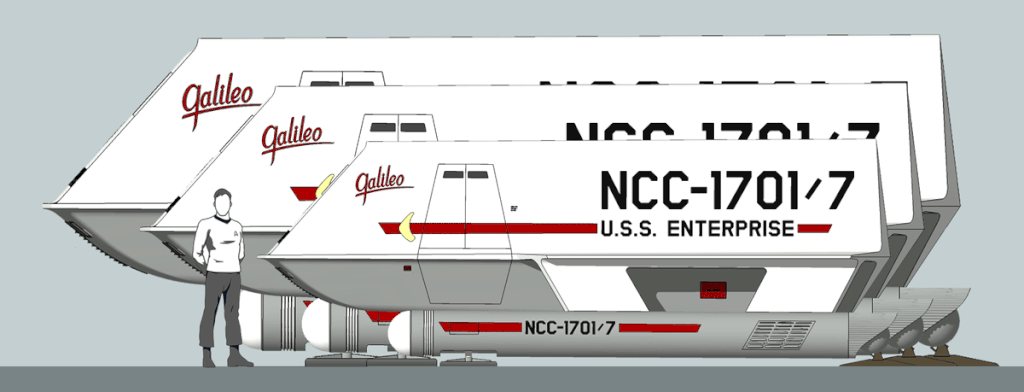
With a lot of mucking around with every valuable inch I reched a compromise of a shuttlecraft about 27 ft. long and with an interior that looks very near exact to what we see onscreen. All I had to do was lower the ceiling to 5'-7" and shorten the main cabin by cutting away the extra space between seats we can easily see onscreen. I also raised the chairs to a normal height off the floor.
You can follow that exercise here:
http://www.trekbbs.com/showthread.php?t=263551
A couple of landed shuttlecraft.
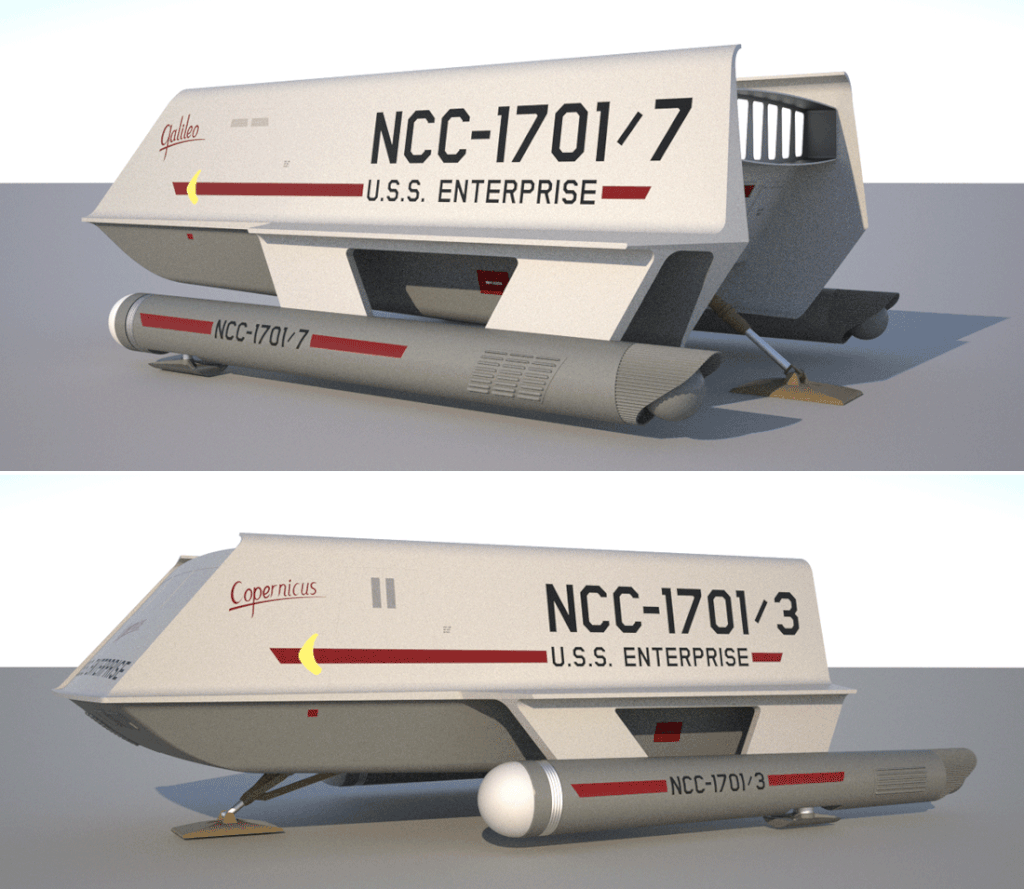
I'm still tweaking it, but here is the forward control console lit up. Yes, I know there are some boo-boos that I made, but this is mostly for proof of concept.
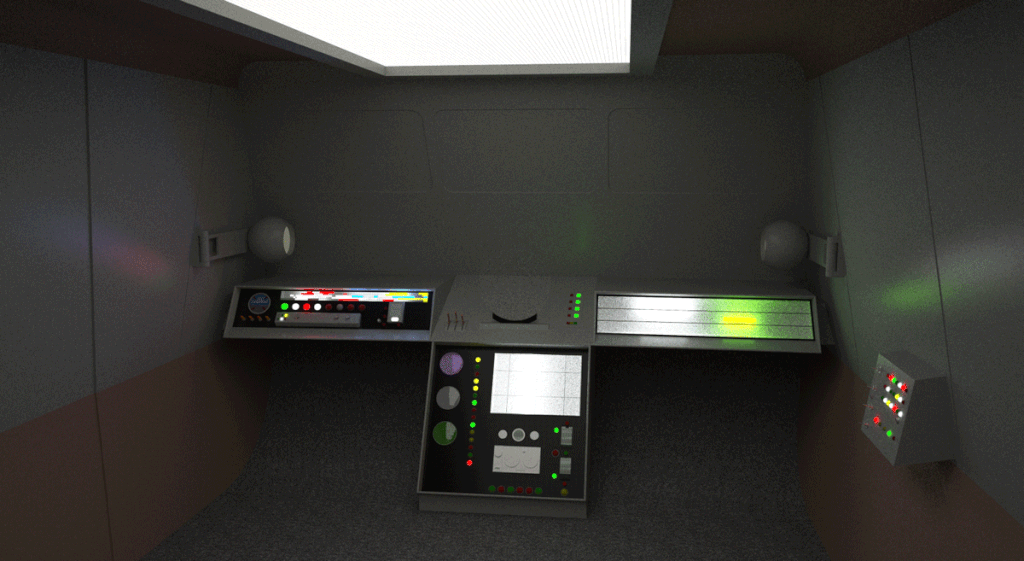
A note about the ceiling. If you look at screencaps from the episodes the lighting panel will look wider in relation to the ceiling. But remember that I lowered the ceiling while still keeping the same shapes of the cabin and keeping the light panel the same width. So inevitably the result is that the ceiling will get proportionately wide as it's lowered because I kept the angle of the side walls the same. So that's why the light panel might look more narrow even though I kept it the same as it was originally.
Looking aft with the aft compartment door open. Yes, I'm trying to think of what detail I can put back in the side we never saw beyond the basic layout I put back there.
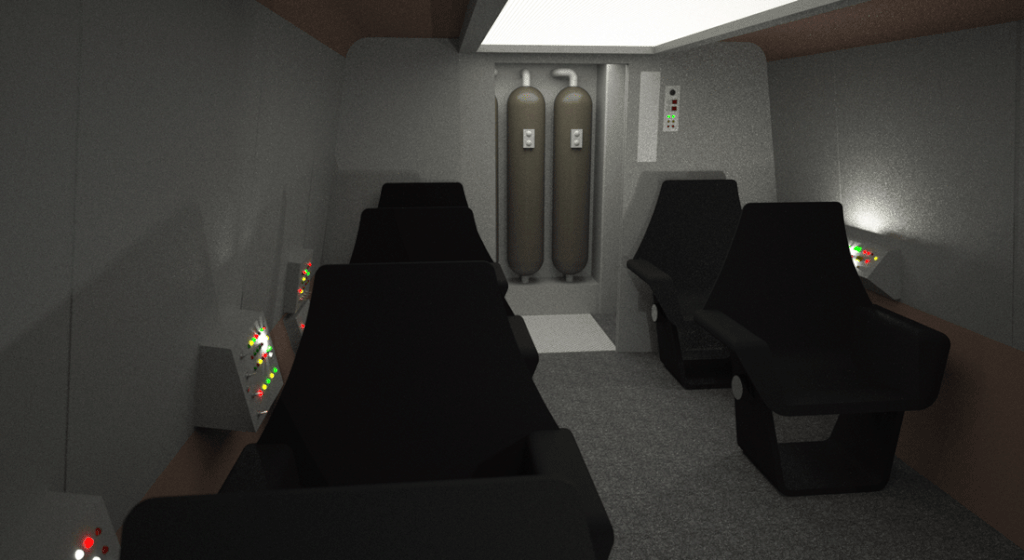
Many of us have long wondered what was in the aft compartment on the port side--something we never saw on TOS. Indeed we saw very little of the starboard side either (which I'm working on presently). So here is my take on it. This is based on the idea of the vehicle having to support up to seven personnel over at least a few hours to several days or even a few weeks duration (the longer the mission duration the likely fewer personnel on board). It's my conjecture that this area in the aft compartment is what the
Galileo crew were primarily tearing apart and jettisoning overboard to lighten the ship's take-off load. My thought is they ripped out (or more likely dismantled with tools) the bulkheads and what they could tear out from behind the bulkheads. My design has large storoage bunkers behind the starboard side bulkhead so they likely threw out whatever might have been stored there as well (possibly environmental suits and assorted gear). Given that two crewman had already died (Latimer and Gaetano) prior to the attempted lift-off then it's likely the remaining crew could have jettisoned two seats now no longer needed, but they ran out of time.

What looks like a familiar toilet is actually the waste management system. Anything that needs to be disposed of (besides human waste) goes into this receptacle that seals tightly before disposing of the contents. A proccessing and recycling system reduces the materiel to its most basic elements and recycles whatever possible into usable elements. If there is anything that cannot safely be recycled then it is either placed into a temporary storage reseptacle or jettisoned into space via a small transporter.
One could also add a form of retractable curtain for additional privacy on the port side of the compartment.
Although it was never explained on TOS the food and matter processing system had to have been quite similar to what was seen on TNG only it was done with the dispensing receptacle covered with a panel. It is effectively a compact transporter system that takes basic elements and rearranges them into new forms. For something like the shuttlecraft which would have a much less extensive system than the
Enterprise the processing system is primarily for a "limited" selection of food and beverages and possible a limited number of other things. By "limited" I mean most likely in comparison to the extensive resources of the
Enterprise while it would be heaven compared to what astronausts must sustain themselves with today.

 Sorry, this makes no sense to me whatsoever. We've seen that phasers can vaporise almost anything, walls, people, eguipment, mugatus etc. etc.
Sorry, this makes no sense to me whatsoever. We've seen that phasers can vaporise almost anything, walls, people, eguipment, mugatus etc. etc.







